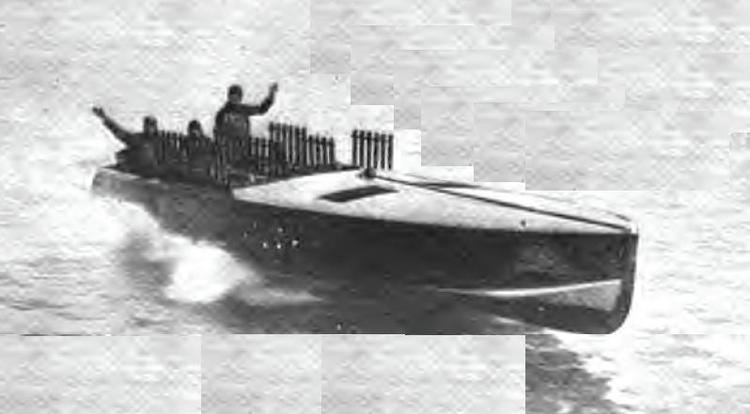Dates August 27–28, 2016 First race 1904 | Track length 2.5 mi (4 km) (TBD?) | |
 | ||
Title sponsor UAW-GM Center for Human Resources Location Detroit River, Detroit, Michigan Most recent winner U-5 Miss Graham TruckingDriver - J. Michael Kelly | ||
APBA Gold Cup is the premier hydroplane boat race in the United States, which is sanctioned by the American Power Boat Association and run as part of the H1 Unlimited season. The race has been contested annually since 1904, and, up until 1990, rotated regularly between locations.
Contents
History
The Gold Cup is the oldest active trophy in motor sports. The trophy was first awarded in 1904 as the APBA Challenge Cup. Hydroplane racing became a tradition in Detroit when designer Christopher Columbus Smith (of Chris-Craft Boats) built a Detroit-based boat that would crack the 60 miles-per-hour speed barrier, capturing the Gold Cup in 1915. The first major race to be run on the Detroit River was the 1916 APBA Gold Cup.
The community-owned Miss Detroit won the Gold Cup in 1915 on Manhasset Bay, outside of New York City, and earned the right to defend it the following year on home waters. Miss Detroit was a single-step hydroplane, equipped with a 250-horsepower Sterling engine. The designer was the distinguished Christopher Columbus Smith of Chris-Craft fame.
The sport's first superstar rose to prominence, winning the 1917 Gold Cup in Minneapolis. Named after two U.S. Presidents, Garfield Wood (aka "Gar") became the personification of power boat competition. This was Wood's first of five consecutive victories as a driver in "the race of races."
In 1920, at the wheel of his twin Smith-Liberty-powered Miss America, Wood averaged a phenomenal 70.412 miles per hour in the 30-mile Final Heat on a 5-mile course. The record would stand until 1946.
In the 1921 Gold Cup, Gar was simply unbeatable. For the next two decades, Gold Cup racing was restricted—supposedly for safety but halted Gar Wood's domination, and also to put the sport into the range of more pocketbooks than had previously been the case. Hydroplane hulls were outlawed and the engine size was limited to 625 cubic inches. Hydroplanes were re-admitted in 1929 and the cubic inch displacement was eventually raised to 732.
A field of thirteen "gentlemen's runabouts" appeared in the 1922 Gold Cup at Detroit. The winner was Jesse Vincent in Packard Chris-Craft with a 90-mile race average of 40.253. The race also marked the debut of the Packard Gold Cup engine, which would hold sway for the next fifteen years.
The first Gold Cup victory by a three-point hydroplane occurred in 1939. Unlike the step hydroplanes, the three-pointers rode on the tips of two pontoon-like running surfaces called sponsons and a completely submerged propeller. (Not until the late 1940s would the boats start to "propride.") The concept would forever alter the course of competitive power boating.
Following World War II, Gold Cup racing resumed. The introduction of converted Allison and Rolls-Royce Merlin aircraft engines, developed and led by D.J. Nolan "The White Haired Boy" and famed aeronautical engineer from GM' Allison Division in Indianapolis, for the war effort, produced new enthusiasm for America's premier powerboat racing event.
Starting in 1963, the Gold Cup race location was determined by the city with the highest financial bid, rather than by the yacht club of the winning boat. The race format was also changed from three heats of 30 miles to four heats of 15 miles. The high bid in 1963 was by Detroit. In the years since, more Gold Cups have been run on the Detroit River than any other location. From 1990 to 2014, all Gold Cup races were contested in the Motor City. In 2015 the Gold Cup was held in Tri-Cities Washington for their 50th anniversary of Gold Cup racing, the 2016 event is in Detroit for their 100th anniversary.
Fran Muncey (Bill Muncey's widow) became the new owner of the Atlas Van Lines boat, and Chip Hanauer took over driving the boat and won the first of his eleven Gold Cups between 1982 and 1999.
Dave Villwock tied down his first Gold Cup with Pico American Dream, owned by Fred Leland, in 1996 and his second with Bernie Little's Miss Budweiser in 1997. Villwock has since claimed three additional Gold Cups for owner Little in 1998, 2000, and 2002. Dave's racing career almost ended following a serious accident in the 1997 Columbia Cup at the Tri-Cities, Washington. Miss Budweiser "blew over" in the final heat and Villwock suffered the loss of two fingers on his right hand.
List of Gold Cup winners
Exceptions: 1904 - The Gold Cup was run & awarded twice 1928 - No contest (no entrants to meet the new rules?) 1942, 1943, 1944, 1945 - No contest (WW II) 1960 - No contest because of high winds (no heats completed) 2008 - Gold Cup declared no contest because of high winds; High Points Championship round was declared completed.
